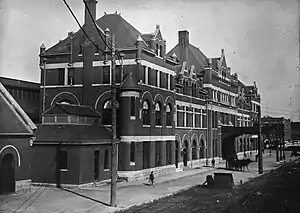Montgomery Union Station
Montgomery Union Station and Trainshed is a historic former train station in Montgomery, Alabama. Built in 1898 by the Louisville and Nashville Railroad, rail service to the station ended in 1979 and it has since been adapted for use by the Montgomery Area Visitor Center and commercial tenants. It was added to the National Register of Historic Places in 1973 and became a National Historic Landmark in 1976.
Montgomery, AL | ||||||||||||||||||||||||||||||||||||||||||||||||||||||||||||||||||
|---|---|---|---|---|---|---|---|---|---|---|---|---|---|---|---|---|---|---|---|---|---|---|---|---|---|---|---|---|---|---|---|---|---|---|---|---|---|---|---|---|---|---|---|---|---|---|---|---|---|---|---|---|---|---|---|---|---|---|---|---|---|---|---|---|---|---|
| inter-city rail station | ||||||||||||||||||||||||||||||||||||||||||||||||||||||||||||||||||
 Montgomery Union Station, c. 1900 | ||||||||||||||||||||||||||||||||||||||||||||||||||||||||||||||||||
| General information | ||||||||||||||||||||||||||||||||||||||||||||||||||||||||||||||||||
| Location | Montgomery, Alabama USA | |||||||||||||||||||||||||||||||||||||||||||||||||||||||||||||||||
| History | ||||||||||||||||||||||||||||||||||||||||||||||||||||||||||||||||||
| Opened | 1898 | |||||||||||||||||||||||||||||||||||||||||||||||||||||||||||||||||
| Closed | 1979 | |||||||||||||||||||||||||||||||||||||||||||||||||||||||||||||||||
| Former services | ||||||||||||||||||||||||||||||||||||||||||||||||||||||||||||||||||
| ||||||||||||||||||||||||||||||||||||||||||||||||||||||||||||||||||
Montgomery Union Station and Trainshed | ||||||||||||||||||||||||||||||||||||||||||||||||||||||||||||||||||
| Coordinates | 32°22′50″N 86°18′51″W | |||||||||||||||||||||||||||||||||||||||||||||||||||||||||||||||||
| Built | 1897 | |||||||||||||||||||||||||||||||||||||||||||||||||||||||||||||||||
| Architect | Benjamin Bosworth Smith | |||||||||||||||||||||||||||||||||||||||||||||||||||||||||||||||||
| Architectural style | Romanesque | |||||||||||||||||||||||||||||||||||||||||||||||||||||||||||||||||
| NRHP reference No. | 73000368 | |||||||||||||||||||||||||||||||||||||||||||||||||||||||||||||||||
| Significant dates | ||||||||||||||||||||||||||||||||||||||||||||||||||||||||||||||||||
| Added to NRHP | July 24, 1973[1] | |||||||||||||||||||||||||||||||||||||||||||||||||||||||||||||||||
| Designated NHL | December 8, 1976[2] | |||||||||||||||||||||||||||||||||||||||||||||||||||||||||||||||||
History


Erected of brick and limestone on a high bluff along the Alabama River, the station was built by Louisville and Nashville Railroad (L&N) in 1898. The station also served passenger trains of Atlantic Coast Line, Western Railway of Alabama, Seaboard Air Line, Central of Georgia, and Gulf, Mobile and Ohio Railroad. The station had six tracks under a 600-foot-long (180 m) shed, with a coach yard on the south end of the station as well as a Railway Express Agency facility. The station's design segregated passengers by race and incorporated Romanesque Revival elements.
L&N trains using the station included the Azalean, Florida Arrow, Humming Bird, Pan-American and South Wind. Traditionally, the Southern Railway's Crescent and Piedmont Limited were routed through the station.
The number of passenger trains using Union Station declined during the 1950s and 1960s. The last Southern Railway train, the Crescent, left in 1970 when that train was rerouted north through Birmingham. The Pan American ended in 1971 when the L&N yielded passenger operations to Amtrak. When Amtrak came into existence in 1971, it continued passenger service through Montgomery with a single train (the South Wind, later renamed the Floridian), operating between Chicago and Miami. However, this train was terminated in 1979 and Union Station was closed.
After a period of disuse, Union Station was renovated for commercial tenants. The train shed still stands, although tracks under it have been replaced by asphalt parking. It was declared a National Historic Landmark in 1976, for its importance in the state's railroad transportation history, and for the train shed, a rare surviving example of a 19th-century gable-roofed shed (most of which were later replaced by balloon sheds).[2][3]
Amtrak returned to Montgomery in 1989 with an extension of the Crescent called the Gulf Breeze from Birmingham to Mobile, but Union Station was not used. Instead, Amtrak contracted with a travel agent who occupied a former grain silo nearby. This Amtrak service was terminated in 1995, and Montgomery has had no passenger rail service since.
Among other tenants, Union Station hosted the Montgomery Area Visitor Center, until it moved to its current location at 1 Court Square.
Gallery
 Looking West, Louisville and Nashville Railroad, Union Station Train Shed
Looking West, Louisville and Nashville Railroad, Union Station Train Shed Union Station Train Shed, 1974
Union Station Train Shed, 1974 Union Station Train Shed, 1974
Union Station Train Shed, 1974.jpg.webp) Union Station Train Shed, 1987
Union Station Train Shed, 1987 Union Station in 2008
Union Station in 2008 The interior of the train shed in 2008.
The interior of the train shed in 2008.
References
- "National Register Information System". National Register of Historic Places. National Park Service. January 23, 2007.
- "Montgomery Union Station and Trainshed". National Historic Landmark summary listing. National Park Service. Archived from the original on January 11, 2008. Retrieved October 24, 2007.
- Zembala, Dennis M. Zembala (August 2, 1976), National Register of Historic Places Inventory-Nomination: Louisville & Nashville Railroad: Montgomery Union Station and Trainshed/Montgomery Union Station (pdf), National Park Service and "Accompanying 5 photos, exterior and interior, from 1925, 1970, 1972, and 1974". (1.87 MB)
External links
- http://www.visitingmontgomery.com Archived 2014-02-07 at the Wayback Machine
- Historic American Engineering Record (HAER) No. AL-1, "Louisville & Nashville Railroad, Union Station Train Shed, Water Street, opposite Lee Street, Montgomery, Montgomery County, AL", 18 photos, 3 data pages, 2 photo caption pages
- HAER No. AL-2, "Union Station, Water Street, Montgomery, Montgomery County, AL", 10 photos, 1 data page, 1 photo caption page

